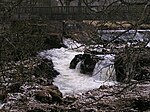Cawood
CawoodCivil parishes in North YorkshireUse British English from November 2018Villages in North Yorkshire

Cawood (other names: Carwood) is a large village (formerly a market town) and civil parish in the Selby District of North Yorkshire, England that is notable as the finding-place of the Cawood sword. It was historically part of the West Riding of Yorkshire until 1974.
Excerpt from the Wikipedia article Cawood (License: CC BY-SA 3.0, Authors, Images).Cawood
Chestnut Road,
Geographical coordinates (GPS) Address Nearby Places Show on map
Geographical coordinates (GPS)
| Latitude | Longitude |
|---|---|
| N 53.833278 ° | E -1.131646 ° |
Address
Chestnut Road (Back Lane)
Chestnut Road
YO8 3TB
England, United Kingdom
Open on Google Maps










